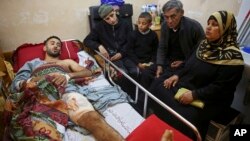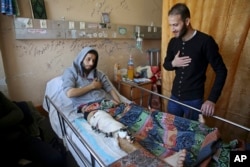Raed Jadallah belonged to an exclusive club, a small band of surfers who escaped the claustrophobia of blockaded Gaza by riding the waves of the Mediterranean. Now he’s immobile, a metal fixation device clamped to his left leg after an Israeli bullet fractured his femur in two places.
The 25-year-old plasterer from a seaside refugee camp said he doesn’t know when he’ll be able to walk again, let alone surf.
“Sea and surfing are everything to me,” he said Wednesday, a day after being discharged from the hospital, his lower body covered by a blanket as he rested on a sofa at his home.
33 dead, 1,300 wounded
Jadallah is among 1,297 Palestinians shot and wounded by Israeli soldiers, including snipers, during the past two weeks of mass protests on the Gaza-Israel border, according to a computerized count by the Gaza Health Ministry. An additional 1,554 Gaza residents have been treated for tear gas inhalation or injuries by rubber-coated steel pellets.
In addition, 33 Palestinians have been killed during this period, including 26 in border demonstrations. The latest casualties came Thursday, when Israel said it bombed Hamas militant targets in the Gaza Strip, killing one Palestinian and wounding another.
The Israeli military has disputed the Gaza count of wounded, saying that at most dozens were struck by Israeli fire. But it has not offered supporting evidence and did not respond to requests for comment.
The casualty figures are at the heart of an intensifying debate over the military’s open-fire orders, branded as unlawful by rights groups because soldiers are permitted to use potentially lethal force against unarmed Palestinians approaching the border fence. Israel has accused Gaza’s Hamas rulers of using the protests as cover for carrying out attacks, including a possible mass breach of the border fence, and says it has a right to defend its sovereign border. It says its sharpshooters have been careful, aiming only at “instigators” involved in attempted attacks.
Protests fueled by dispair
The protests have been organized by Hamas, but have also been fueled by widespread despair among the territory’s 2 million people. Gaza has endured more than a decade of border closures, imposed by Israel and Egypt after the Islamic militant group seized the territory in 2007, a year after winning Palestinian parliament elections.
More bloodshed on the border is likely, with organizers calling for protests to continue until mid-May and Israel saying it won’t change its rules of engagement.
Hospitals straining
Already, the recent surge of patients with gunshot wounds has severely taxed Gaza’s clinics and hospitals.
Gaza’s health system has been buckling under years of shortages of essential medicines and equipment caused by the blockade and Hamas’ power struggle with the rival Palestinian Authority, doctors say. The West Bank-based Palestinian Authority accuses Hamas of selling medicines it sends, while Hamas accuses it of delaying medicine shipments.
The violence comes at a time when 40 percent of basic medicines are no longer in stock in Gaza hospitals, according to the World Health Organization. Equipment is also in short supply. At Gaza’s main hospital, Shifa, half of 200 available fixators had been used up for bones broken by bullets, officials said.
Doctors carefully manage scarce resources, said Ayman Sahbani, the spokesman and emergency room director at the Shifa Hospital. Those with relatively simple soft-tissue gunshot wounds are treated and sent home the same day to make room for the most serious cases and new arrivals, he said.
Earlier this week, 64 patients with complications from gunshot wounds, mainly sustained in large protests on two consecutive Fridays, were still hospitalized, filling up orthopedic and surgery wards.
A majority suffered either open, compound or multiple fractures, or damage to blood vessels, said Sahbani, adding that there is concern about permanent disability in some cases.
“A noticeable number of the gunshot injuries comprise an exit point larger than the entry point, suggesting explosive bullets,” he added.
The European Hospital in southern Gaza received 100 people with gunshot wounds last Friday, including 78 who remained hospitalized this week, said spokesman Yehiyeh Nawajha. Among the wounded are four women, he said.
Tracking the injured
The Gaza Health Ministry runs a data collection system known as “e-hospital.”
Detailed injury reports are entered from field hospitals, clinics and Gaza’s main hospitals, with patients identified by name, ID number and type of injury. The system eventually detects and removes any duplicates that might occur if a patient is transferred from one hospital to another, said ministry official Hani al-Wehidi.
For example, 82 people were initially admitted to a north Gaza hospital, but four names were later removed to avoid double counting, he said.
He said the count is transparent and reliable.
“Anyone can come and see our work,” he said.
UN, others send help
The U.N. children’s agency, UNICEF, has sent more supplies to Gaza hospitals, including 27 essential drugs and medical supplies, including saline and glucose, critical for treating serious injuries.
An Israeli group, Physicians for Human Rights Israel, is sending eight Arab doctors from Israel to Gaza in anticipation of more injuries Friday. It also will deliver insulin syringes collected by Israeli volunteers in a Facebook campaign.
The group called the Palestinian health care system “one of the major victims” of Israel’s blockade.












